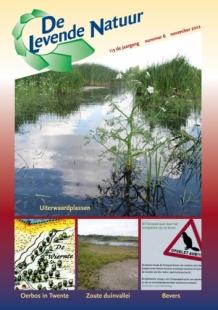De Levende Natuur nummer 6 van 2012 (English summary)
Afbeelding

The Wiernte or Drieschigt; communal woodland at the edge of the Almelosche Veen
P. Bremer & R. During
For a long time the Beekbergerwoud has been known as the last `primaeval` woodland of the Netherlands. The article is about an other ancient, primary woodland near Mander (NO-Twente) which impressed people by its `primaeval` character. The woodland, intersected by small streams, belonged to the Fago-Quercetum and became overgrown by a bog vegetation. It was cut in 1845 but according to the authors remnants survived till 1931 - 1934.
Perspectives for macrophytes in semi-stagnant floodplain lakes
G.J. van Geest & T. Buijse
In the years 1999 – 2010 a large-scale investigation has been carried out to study the factors that determine the composition and abundance of aquatic vegetation in floodplain lakes along the Lower Rhine. All studied lakes could be flooded by the river; however, none of the lakes were permanently connected to the main channel. Aquatic vegetation cover was negatively related to surface area and depth of the lakes, and duration of river flooding. By contrast, seepage and groundwater-induced water level fluctuations (resulting in temporal drawdown of lakes) had a positive influence of cover and species richness of aquatic vegetation. Therefore, to improve conditions for aquatic vegetation, measures that enhance the importance of seepage and groundwater-induced water level fluctuations should be promoted. Furthermore, the waterbodies should be shallow (max. depth < 2 meter) and small (< 2-3 ha), and the long-term average duration of river flooding is less than 20 days/year.
Threats of drought for dragonflies in dune areas
J.J. Beukema & R. Manger
In dune areas, dragonflies (Odonata) mostly depend on small and shallow ponds and pools. For over 10 years, numbers of dragonflies were monitored at ponds in the dunes of the northern part of Holland. At all pools, their abundances were strongly reduced at low water levels after periods of drought. Such declines were more substantial at shallow than at deeper ponds. In ponds that had run dry completely, recovery of numbers took 2 or 3 years in damselflies (Zygoptera), whereas the larger Anisoptera immigrated more rapidly and reached the usual numbers within the first year. Deepening of shallow pools or digging of new pools resulted in higher abundances, again much faster in Anisoptera than in Zygoptera. To keep dune areas well populated by dragonflies, we advise to maintain sufficient pond depths.
A management experiment with salt addition in a duneslack
W. van Steenis & M.P. van Zuijen
An artificial duneslack, man made in 1998, suffered from encrouchment of willows (Salix spp.). Since mowing and grazing would be tenacious, we tried to manage willows by adding a 1 cm thick layer of salt. This reduced and even removed willows and birch almost completely. Development of other typical duneslack plant species was hardly influenced after ten years.

